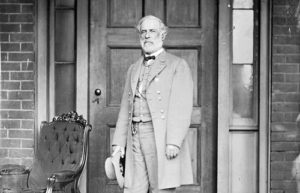On August 11-12 2017, Charlottesville, Virginia saw clashes between the far-right and their opponents, which led to three deaths (including the crew of a crashed police helicopter, and of course, Heather Heyer, an anti-fascist demonstrator who was run down by a fascist in an automobile), and 38 wounded. This incident brought a very heated conflict in American society to the surface.
Charlottesville is a college town with a population of about 49 thousand people. It is the home of two American presidents: Thomas Jefferson (the author of the Declaration of Independence, whose plantation is only three miles away) and James Monroe (the author of the eponymous doctrine, which claimed the exclusive right of the United States to dominate Western Hemisphere). During the American Civil War, Charlottesville was under Confederate control, but it did not see much fighting.
The statue of Confederate General Robert E. Lee, the decision to tear down which served as the formal trigger for the clashes, was erected in 1924. The majority of the Confederate statues in the South were erected in two time periods:
– The 1910-20s, during the explosive growth of the Ku-Klux-Klan’s popularity in the South, and a time when local legislatures passed so-called “Jim Crow laws”, which served to politically disenfranchise black people, and to enforce racial segregation
– The 1960s, as part of combating the Civil Right Movement and the repeal of the Jim Crow laws.

In this sense, Confederate monuments represent not so much the desire of southerners to preserve the memory of their ancestors, but rather they serve as ideological support for contemporary political goals.
Two competing myths about the Civil War exist in the United States:
– The winning side of the northerners, or the Yankees, along with people of a liberal persuasion, who tend to vote Democrat, view the war as one between morality and immorality. That the northern states fought against slavery, while the Confederates defended it.
– The southerners, along with people of a conservative persuasion, who tend to vote Republican, consider the war to be over a conflict between states’ rights and federal rights.
Formally speaking, both of these claims have facts behind them. However, they ignore the apparent economic basis of the conflict. The capitalist economy of the United States consisted of two main components, the industrial North and the agrarian South. And if the industrial capital of the North was founded on exploiting cheap labor, including that of immigrants (it is by no accident that Howard Zinn in his A People’s History of the United States refers to the conflict between the northern industrialists and the workers as “The Other Civil War”), then the agrarian capital of the South, lacking its own large supply of cheap labor, placed its bet on slave labor in order to guarantee the maximum profitability of its cotton and tobacco on domestic and foreign markets. The northern industrialists, on the other hand, viewed the slaves as another potential source of cheap factory labor, if it were possible to take them off the southern plantations and to direct them to the North en masse. The subsequent history of the United States proved these expectations to be well-founded.

Thus, the refusing to excessively idealize the conflicting sides draws to the surface the economic basis of the conflict: the fight between regional capitalist elites over the right to exploit black labor in order to guarantee their regions the upper hand in the federal system.
Ultimately, the North won this fight. But the dynasties of southern plantation owners remained, and the dreamed of revenge. Though they were not feudal elites in the strict sense of the word, the plantation owners adopted the role of aristocracy, contraposing their idyllic myth of antebellum spiritual richness with the greed-driven primitivism of the North. Margaret Mitchell’s novel Gone With the Wind and its film adaptation are excellent examples of this.
While creating the myth of an antebellum golden age, the southern revanchists also aimed to pit poor whites against the newly liberated blacks, who having been freed from slavery, became sharecroppers and day laborers, thus entering into competition with the white day laborers. To achieve this aim, they used race theory, claiming that black people were subhuman in nature. The Ku-Klux-Klan, a secret pseudo-masonic terrorist organization founded by former Confederate general Nathaniel Bedford Forrest, united the plantation owners, who longed for the return of their golden age, and made up the leadership, and the embittered poor whites, who became its rank-and-file members, around the triune ideology of white supremacy, antisemitism, and anti-Catholicism. D.W. Griffith’s “Birth of a Nation” became its aesthetic manifesto.
At the same time as this film came onto the big screen, southern cities began to massively erect Confederate monuments. The fight against these monuments began with the Black Lives Matter movement (BLM) entering onto the political stage as a reaction to the disproportionate use of force by law enforcement against black people and to increasing attacks on black people by the far-right. One of many examples is the shooting of a black church in South Carolina by a fascist-inspired thug in 2015.
From the very beginning, BLM activists adopted an uncompromising stance against then presidential candidate Donald Trump. The far-right, including KKK’s top-brass, repeatedly expressed their universal support for Trump. In this way, we see the continuation of a longstanding conflict within the US, the roots of which lie in a successful manipulation, which led to a split within the exploited working class along racial lines to such a point, that the conflict between black and white in America has become more heated than the conflict between rich and poor.
(to be continued…)
Source (for copy): https://eu.eot.su/2017/10/12/charlottesville-and-the-war-on-american-history/
This is the translation of an article by Lev Korovin, first published by Rossa Primavera News Agency
We encourage republishing of our translations and articles, but ONLY with mentioning the original article page at eu.eot.su (link above).




